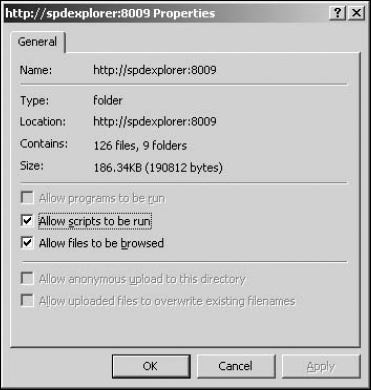23.3. Using Administration Features
While most of the administrative operations on Web sites are performed on a Web server, SharePoint Designer also provides you with some options that either take you to the administrative console on the Web server or let you perform the management operations in the SharePoint Designer user interface itself. For example, if you want to set a Web page as the default home page for your Web site, you don't really need to go to the IIS management console on the Web server to make this change. You can just right-click on the page and then choose Set as Home Page from the popup menu. This automatically makes the Web page the default page for the Web site.
When working with remote Web sites residing on a Web server, you can change Web site server properties by using the Properties menu option available by right-clicking on the site root folder in the Folder List task pane. As shown in Figure 23.8, the Properties dialog box allows you to change the execute permissions for the Web site:
Allow scripts to be run: This option lets you configure the Web site folder to allow for execution of scripts, such as ASP, ASP.NET, etc.
Allow files to be browsed: This option allows you to specify if files in the folder can be browsed to.
Allow anonymous uploads to this directory: Only available if the Allow scripts to be run check box is deselected, this option allows you to specify if anonymous users can upload files to a folder on a Web server.
Allow uploaded files to overwrite existing filenames: Only available if the Allow scripts to be run check box is deselected, this option allows for overwriting if the files being uploaded already exist.
These options are also available on the folders that exist on the Web site. Also, when working with FPSE Web sites, the Convert to Web option is available for folders. This menu option converts a folder into an FPSE-enabled subsite. If you right-click on a subsite, you also have an option to convert the subsite to a folder, which demotes the subsite to a simple folder by deleting FPSE metadata information from it.
Figure 23.8. The Properties dialog box for an FPSE Web site

23.3.1. Managing site settings
As discussed earlier, the Site Settings dialog box in SharePoint Designer can be used to find information about the Web site, the type of Web server, and the version of FPSE or SharePoint installed on the site. As shown in Figure 23.9, when working with FPSE sites in SharePoint Designer, the option to remove hidden metadata from the Web site isn't available in the Site Settings dialog box.
Figure 23.9. The Site Settings dialog box for an FPSE-enabled Web site

This ensures that an author doesn't inadvertently remove important FPSE metadata information from an FPSE-enabled Web site, thereby causing serious problems with the underlying infrastructure that sustains the Web site.
23.3.2. Recalculating hyperlinks
It's possible that during file move operations, such as import, export, publishing, etc., a network failure may lead to a mismatch in the FPSE hidden metadata for a Web site. This mismatch can cause many features that rely on the hidden metadata to either fail or perform erratically. Recalculate Hyperlinks is a mechanism that FPSE sites offer as a way to repair any broken hyperlinks, FPSE-based components, and hidden metadata of the Web site.
You can easily start the Recalculate Hyperlinks operation by choosing Site ![]() Recalculate Hyperlinks. As the Recalculate Hyperlinks message box indicates, the operation tries to repair all hyperlinks, updates information for all FrontPage components, and synchronizes metadata associated with the Web site.
Recalculate Hyperlinks. As the Recalculate Hyperlinks message box indicates, the operation tries to repair all hyperlinks, updates information for all FrontPage components, and synchronizes metadata associated with the Web site.
NOTE
It's advisable to run Recalculate Hyperlinks in situations where you experience rendering and update issues with FrontPage Web components, such as link bars, bars based on navigation structure, etc.
23.3.3. Using Administration options
For FPSE sites, the Site ![]() Administration menu option is also enabled. This menu option allows you to quickly open some FPSE administration Web pages for performing management tasks:
Administration menu option is also enabled. This menu option allows you to quickly open some FPSE administration Web pages for performing management tasks:
Administration Home: This takes you to the root FPSE administration Web page for the Web site that you have open in SharePoint Designer.
Permissions: Opens the Permissions administration Web page for FPSE, which allows you to manage users, change FPSE roles, etc.
Change Password: If the user opening the site in SharePoint Designer has been created by using the FPSE administrative pages, this option opens a Web page that allows the user to change his or her password.
Backup Web Site: Available for backward-compatibility, you can use this option to back up your FPSE site.
Restore Web Site: Use this option to restore from a backup that has been created with the Backup Web Site menu option.
